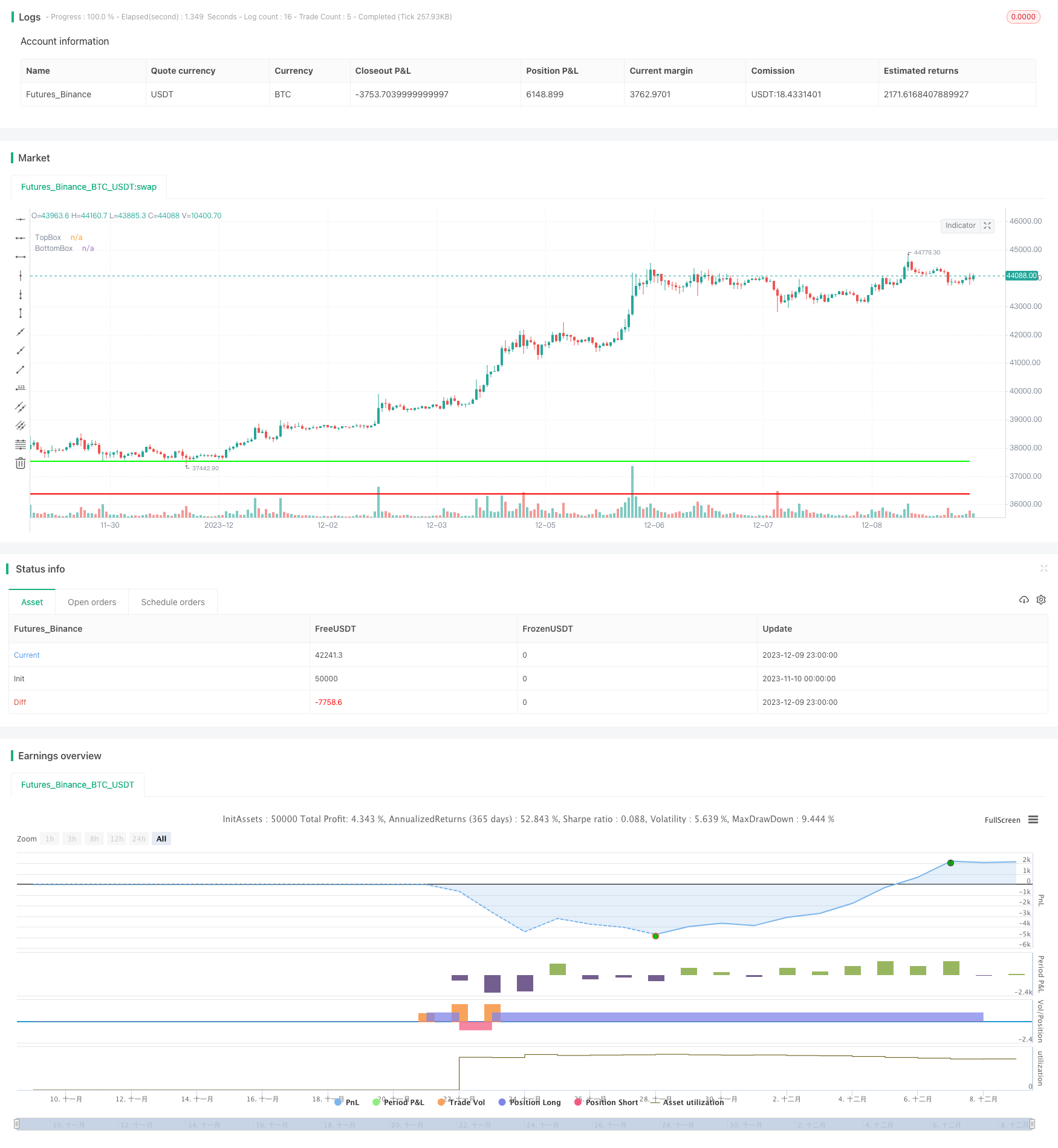
概述
52周高低盒子交易策略是一种以价格在不同区间震荡形成的”盒子”为交易信号的策略。该策略的核心逻辑是,当价格突破某一区间(盒子)的上下限时,表明价格进入新的区间,这时可以进行买入或卖出操作。
策略原理
该策略通过计算最近5天(可调整)的最高价、最低价,判断价格是否进入新的交易区间。具体规则如下:
- 计算最近5天内的最高价(Highest High)和最低价(Lowest Low),构成一个交易区间盒子。
- 当价格突破该区间的上限时,表明可能进入更高的区间,可以进行买入操作。
- 当价格跌破该区间的下限时,表明可能进入更低的区间,可以进行卖出操作。
- 将止损位设置为上一个区间的上下限附近,以控制风险。
- 重复上述判断,不断调整交易区间,实现盈利。
通过这样的区间突破来判断趋势和发出交易信号,是该策略的核心思想。
优势分析
52周高低盒子交易策略具有以下几个优势:
- 策略思路简单直观,容易理解实现。
- 能够抓住价格进入新区间后的趋势行情。区间突破是比较可靠的交易信号。
- 有明确的止损策略,可以有效控制风险。
- 可以通过调整区间长度来适应不同周期和不同品种的行情。
总的来说,这是一种风险控制能力较好,较为实用的趋势交易策略。
风险分析
该策略也存在一些风险,主要包括:
- 当趋势不明显时,会产生多个小损失的情况。
- 区间范围设定不当也会增加错误交易的概率。
- 止损策略并不能完全规避巨大行情跳空的风险。
这需要交易者在实践中不断测试和优化策略的参数,谨慎进行风险管理。
优化方向
52周高低盒子交易策略还可以从以下几个方面进行优化:
- 结合交易量或者均线指标来验证买卖信号,提高准确率。
- 优化区间的长度参数,适应市场的变化。
- 可以在突破买入后,等待回调构成更多重入机会。
- 结合复利原理,每次止损后可适当加仓,追求更高收益。
在实践过程中,通过参数调整和规则优化,可以不断提升该策略的效果。
总结
52周高低盒子交易策略是一个基于价格突破区间判断趋势方向的策略。它有着简单的交易逻辑、强大的风险控制能力。在实践中需要不断测试和优化,充分发掘该策略的优势。总的来说,这是一种值得推荐的实用交易策略。
策略源码
/*backtest
start: 2023-11-10 00:00:00
end: 2023-12-10 00:00:00
period: 1h
basePeriod: 15m
exchanges: [{"eid":"Futures_Binance","currency":"BTC_USDT"}]
*/
// This source code is subject to the terms of the Mozilla Public License 2.0 at https://mozilla.org/MPL/2.0/
// © ceyhun
//@version=4
strategy ("Darvas Box Strategy",overlay=true)
boxp=input(5, "BOX LENGTH")
D_High = security(syminfo.tickerid, 'D', high)
D_Low = security(syminfo.tickerid, 'D', low)
D_Close = security(syminfo.tickerid, 'D', close)
D_Open = security(syminfo.tickerid, 'D', open)
LL = lowest(D_Low,boxp)
k1 = highest(D_High,boxp)
k2 = highest(D_High,boxp-1)
k3 = highest(D_High,boxp-2)
NH = valuewhen(D_High>k1[1],D_High,0)
box1 = k3<k2
TopBox = valuewhen(barssince(D_High>k1[1])==boxp-2 and box1, NH, 0)
BottomBox = valuewhen(barssince(D_High>k1[1])==boxp-2 and box1, LL, 0)
plot(TopBox, linewidth=2, color=#00FF00, title="TopBox")
plot(BottomBox, linewidth=2, color=#FF0000, title="BottomBox")
if crossover(D_Close,TopBox)
strategy.entry("Long", strategy.long, comment="Long")
if crossunder(D_Close,BottomBox)
strategy.entry("Short", strategy.short, comment="Short")
更多内容